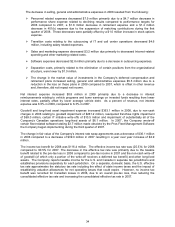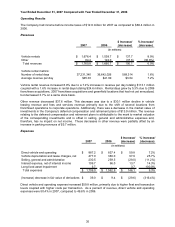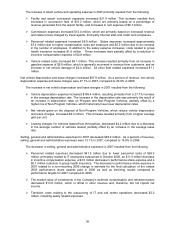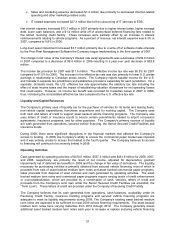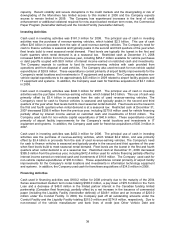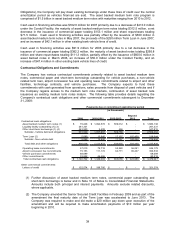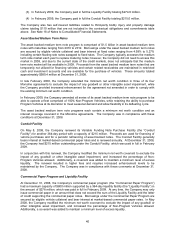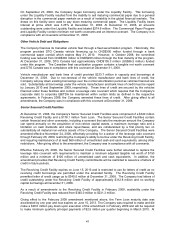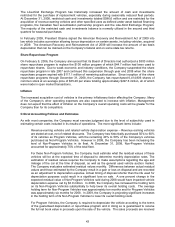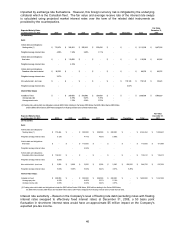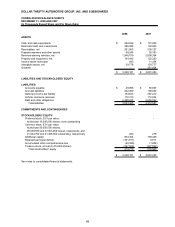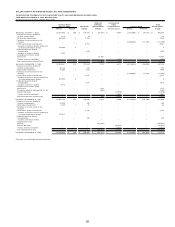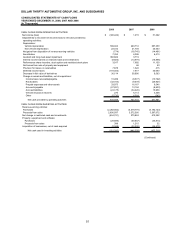Thrifty Car Rental 2008 Annual Report Download - page 44
Download and view the complete annual report
Please find page 44 of the 2008 Thrifty Car Rental annual report below. You can navigate through the pages in the report by either clicking on the pages listed below, or by using the keyword search tool below to find specific information within the annual report.December 31, 2008, the Company had $178.1 million outstanding under the Term Loan. For further
discussion of the Senior Secured Credit Facilities see Note 21 of Notes to Consolidated Financial
Statements.
Debt Servicing Requirements
The Company will continue to have substantial debt and debt service requirements under its financing
arrangements. As of December 31, 2008, the Company’s total consolidated debt and other obligations
were approximately $2.5 billion, of which $2.3 billion was secured debt for the purchase of vehicles. The
majority of the Company’s vehicle debt is issued by special purpose finance entities as described herein
all of which are fully consolidated into the Company’s financial statements. The Company has scheduled
annual principal payments for vehicle debt of approximately $810 million in 2009, of which approximately
$490 million was paid in February 2009, and approximately $500 million per year from 2010 through
2012. At December 31, 2008, the Company had no scheduled principal payments on its Term Loan until
2014. However, subsequent to December 31, 2008 and including the effect of the recent amendment,
the Company paid $20 million of the Term Loan balance in February 2009 and will be required to make
amortization payments of $10 million per year from 2010 through 2012 with the remaining lump sum due
in 2013.
The Company intends to use cash generated from operations and from the sale of vehicles for debt
service and, subject to restrictions under its debt instruments, to make capital investments. The Company
has historically repaid its debt and funded its capital investments (aside from growth in its rental fleet) with
cash provided from operations and from the sale of vehicles. The Company has funded growth in its
vehicle fleet by incurring additional secured vehicle debt and with cash generated from operations.
The Company has significant requirements for bonds and letters of credit to support its insurance
programs and airport concession obligations. At December 31, 2008, various insurance companies had
$47.2 million in surety bonds and various banks had $65.3 million in letters of credit to secure these
obligations. At December 31, 2008, these surety bonds and letters of credit had not been drawn upon.
Interest Rate Risk
The Company’s results of operations depend significantly on prevailing levels of interest rates because of
the large amount of debt it incurs to purchase vehicles. In addition, the Company is exposed to increases
in interest rates because a portion of its debt bears interest at floating rates. The Company estimates that,
in 2009, approximately 20% of its average debt will bear interest at floating rates. The amount of the
Company’s financing costs affects the amount the Company must charge its customers to be profitable.
See Note 10 of Notes to Consolidated Financial Statements.
Like-Kind Exchange Program
The Company utilizes a like-kind exchange program for its vehicles whereby tax basis gains on disposal
of eligible revenue-earning vehicles are deferred (the “Like-Kind Exchange Program”). To qualify for Like-
Kind Exchange Program treatment, the Company exchanges (through a qualified intermediary) vehicles
being disposed of with vehicles being purchased allowing the Company to carry-over the tax basis of
vehicles sold to replacement vehicles, with certain adjustments. The Like-Kind Exchange Program has
resulted in a material deferral of federal and state income taxes, as well as net operating loss
carryforwards (“NOLs”), both of which are reflected in deferred taxes on the balance sheet at December
31, 2008. The benefit of the deferral is dependent on timely reinvestment of vehicle disposition proceeds
in replacement vehicles; therefore, a downsizing of the Company’s fleet or reduced vehicle purchases
could result in reduced deferrals and significant increased payments of federal and state cash income
taxes, after considering the effect of net operating loss carryforwards. In November 2008, the Company
elected to temporarily suspend the Like-Kind Exchange Program, allowing proceeds from sales of
vehicles to be utilized for future debt reduction rather than restricting those proceeds only to future vehicle
purchases. The Company plans to utilize its existing NOLs to offset the gains from the sales of vehicles
during the suspension period. To the extent that taxable sales proceeds exceed the Company’s NOLs,
the suspension could result in the payment of cash taxes. In order to minimize potential cash tax
payments, the Company reinstated the Like-Kind Exchange Program in January 2009, after it completed
the sale of units in inventory. The Company does not believe it will have any significant cash liability for
the taxes due to the temporary suspension of the Like-Kind Exchange Program.
42




